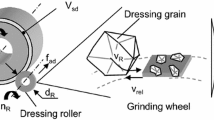Abstract
Many advantages make electrolytic in-process dressing (ELID) grinding desirable for cutting hard and brittle material with high surface requirements. The self-electrolytic in-process dressing property in ELID grinding is also largely responsible for the shorter wear life and lower forming accuracy of the grinding wheel. In ELID grinding, except for traditional mechanical wear, the electrolytic oxidation wear also adds more uncertainties to the wear velocity of the grinding wheel. To date, few investigations focused on the grinding wheel wear life characterization in ELID cut-in grinding of ball bearing raceway. In this study, the wear life characterization of the grinding wheel during ELID grinding was quantitatively simulated by a moving normal distribution curve of the grit state variation. As all types of cutting grits wear out, so did the normal distribution curve, showing movement towards the grinding wheel center. With the normal distribution curve moving towards the grinding wheel center, a local acceleration and local deceleration in moving velocities occurred. It is the diversity of the moving speed of the normal distribution curve that provides a quantitative description to understand the wear life characterization of the ELID grinding wheel. Some experimental results can easily explain this new proposed perspective. This new perspective can also be extended to predict the forming accuracy and surface topography of the bearing raceway during ELID grinding.
Similar content being viewed by others
References
Lynagh N, Rahnejat H, Ebrahimi M, Aini R (2000) Bearing induced vibration in precision high speed routing spindles. Int J Mach Tool Manu 40:561–577
Alfares MA, Elsharkawy AA (2003) Effects of axial preloading of angular contact ball bearings on the dynamics of a grinding machine spindle system. J Mater Process Technol 136:48–59
Qian J, Li W, Ohmori H (2000) Precision internal grinding with a metal-bonded diamond grinding wheel. J Mater Process Technol 105:80–86
Ohmori H, Katahira K, Akinou Y, Komotori J, Mizutani M (2006) Investigation on grinding characteristics and surface-modifying effects of biocompatible Co-Cr alloy. CIRP Ann Manuf Technol 55:597–600
Ohmori H, Nakagawa T (1997) Utilization of nonlinear conditions in precision grinding with ELID (electrolytic in-process dressing) for fabrication of hard material components. CIRP Ann Manuf Technol 46:261–264
Malkin S, Cook NH (1971) The wear of grinding wheels. J Eng Ind 93:1120–1133
Malkin S, Guo C (2007) Thermal analysis of grinding. CIRP Ann Manuf Technol 56:760–782
M.C. Shaw Fundamentals of the grinding process, im: M.C. Shaw(Ed.), Proceedings of the International Grinding Conference, Carnegie Press, Pittsburgh, PA, 1972, 220–258
Zhu Y, Ding W et al (2017) Investigation on stress distribution and wear behavior of brazed polycrystalline cubic boron nitride superabrasive grains: numerical simulation and experimental study. Wear 376-377 (1234–1244
Ding W-F, Xu J-H et al (2010) Wear behavior and mechanism of single-layer brazed CBN abrasive wheels during creep-feed grinding cast nickel-based superalloy. Int J Adv Manuf Technol 51:541–550
Wenfeng D, Linke B et al (2017) Review on monolayer CBN superabrasive wheels for grinding metallic materials. Chin J Aeronaut 30:109–134
Jawahir IS, Brinksmeier E, M'Saoubi R, Aspinwall DK, Outeiro JC, Meyer D, Umbrello D, Jayal AD (2011) Surface integrity in material removal processes: recent advances. CIRP Ann 60:603–626
Arrazola PJ, Özel T, Umbrello D (2013) Recent advances in modelling of metal machining processes. CIRP Ann Manuf Technol 62:695–718
Brinksmeier E, Aurich JC, Govekar E, Heinzel C, Hoffmeister HW, Klocke F, Peters J, Rentsch R, Stephenson DJ, Uhlmann E, Weinert K, Wittmann M (2006) Advances in modeling and simulation of grinding processes. CIRP Ann Manuf Technol 55:667–696
Sun J, Qin F, Chen P (2016) A predictive model of grinding force in silicon wafer self-rotating grinding. Int J Mach Tools Manuf 109:74–86
HaoNanLi, DragosAxinte, On a stochastically grain-discretised model for 2D/3D temperature mapping prediction in grinding, 116 (2017)60–76
Backer WR, Marshall ER, Shaw MC (1952) The size effect in metal cutting. Trans ASME 74:61–72
Shaw MC, Farmer DA, Nakayama K (1967) Mechanics of the abrasive cut-off operation. J Eng Ind 89:495–502
Brecker JN, Shaw MC (1974) Measurement of the effective number of cutting points in the surface of a grinding wheel, in: Proceeding of the international Conference on Production Engineering, Japan Society of Precision Engineers, Tokyo, 740–745
Wu ML, Ren CZ, Zhang KF (2015) ELID groove grinding of ball bearing raceway and the accuracy durability of the grinding wheel. Int J Adv Manuf Technol 79:1721–1731
Wu ML, Zhang KF, Ren CZ (2015) Study on the non-uniform contact during ELID groove grinding. Precis Eng 39:116–124
Jiang JL, Ge PQ, Bi WB (2013) 2D/3D ground surface topography modeling considering dressing and wear effects in grinding process. Int J Mach Tool Manu 74:29–40
Hou ZB, Komanduri R (2003) On the mechanics of the grinding process—part I. Stochastic nature of the grinding process. Int J Mach Tools Manuf 43:1579–1593
Zhang K, Ren C, Lijian Y, Li Q, Jin X (2012) Precision internal grinding of bearing steel based on the state control of oxide layer with electrolytic in-process dressing. J Mater Process Technol 212:1611–1621
Zhang K, Ren C, Lijian Y, Li Q (2013) Precision grinding of bearing steel based on active control of oxide layer state with electrolytic interval dressing. Int J Adv Manuf Technol 65:411–419
Zhang K (2013) Dissertation, Theoretical and experimental investigations on ELID grinding for the ring raceway of ball bearing, Tianjin University
Funding
The authors would like to acknowledge to the Tianjin application foundation and advanced technology research project (Contract no.15JCZDJC39500) and National Science Foundation of China (Contract no. 51675377) for providing the financial support to complete this work.
Author information
Authors and Affiliations
Corresponding author
Rights and permissions
About this article
Cite this article
Wu, M.L., Ren, C.Z. & Zhang, K.F. Wear life characterization of the grinding wheel for electrolytic in-process dressing (ELID) grinding of ball bearing raceways: a new perspective based on a moving normal distribution curve of the grit state variation. Int J Adv Manuf Technol 96, 1919–1928 (2018). https://doi.org/10.1007/s00170-018-1694-6
Received:
Accepted:
Published:
Issue Date:
DOI: https://doi.org/10.1007/s00170-018-1694-6



